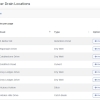
EPA’s 2015 NPDES Electronic Reporting Rule (the “e-Rule”) postponed many Phase II requirements to give states time to build electronic portals. That grace period ends 21 December 2025, so every small MS4 must now file Notices of Intent (NOIs), annual reports, and other submittals online rather than on paper. The rule is meant to improve data accuracy, public transparency, and enforcement efficiency. (epa.gov)
Several states used the e-Rule deadline as a springboard to modernise their own MS4 general permits. New York’s SPDES GP-0-24-001 became effective 3 January 2024; Massachusetts and Maine released draft 2024-25 permits; other states are following suit. All of them tighten minimum control measures (MCMs) and clarify deliverables ahead of the federal electronic-reporting cut-off. (waldenenvironmentalengineering.com, www3.epa.gov)
| Theme | What’s new | Example wording / deadline |
|---|---|---|
| Electronic submittals | Mandatory eNOIs, semi-annual certifications & annual reports through state/NeT portals | NY eNOI due 20 Feb 2024; first annual report due 1 Apr 2025 (waldenenvironmentalengineering.com) |
| Expanded system mapping | Phased, GIS-ready inventories of every outfall, catch basin, culvert and drainage asset | NY requires a “clear understanding of the MS4” map; format flexible but must meet schedule milestones (waldenenvironmentalengineering.com) |
| Sharper MCM deliverables | All six MCMs remain, but each now carries quantifiable BMP targets, public-involvement metrics and timelines | NY clarifies target audiences & topics for MCM 1; IDDE now must include public reporting portal (waldenenvironmentalengineering.com) |
| Low-Impact Development (LID) performance standards | Permits are being modified so local ordinances include clear, measurable standards for each LID BMP (e.g., retention depth, runoff‐reduction %) | April 2025 draft modification requires adopting Table 1-F performance criteria in municipal code (epa.gov) |
| Environmental justice & equity | Outreach plans and retrofit prioritisation must show how underserved neighbourhoods benefit | 2024 draft MA permit ties public-education languages and SCM retrofits to EJ screening tools (www3.epa.gov) |
Compliance risk rises after 2025. Electronic dashboards make it easier for regulators—and the public—to spot missing reports or weak metrics.
Data-heavy requirements favour organised inventories. If your drainage system lives in a dozen spreadsheets, meeting the new mapping and IDDE traceability rules will be painful. An asset-management tool such as Roadwurx (for small agencies) or Cartegraph (for larger systems) centralises those data and auto-feeds report fields.
Performance standards = capital planning leverage. Quantified LID criteria and EJ-focused retrofit schedules give you concrete justifications when you ask councils for budget, grants or bond funding.
Public visibility pushes outreach quality. With e-Rule data flowing into EPA’s ECHO portal, residents can instantly see whose stormwater plan is late or ineffective—raising reputational stakes for local governments.
Read your state’s 2024-25 draft/final MS4 permit and flag every new deliverable date in a shared calendar.
Switch to e-reporting now. Create NeT/portal log-ins for all staff who sign submittals; test the upload workflow with a dummy file.
Complete a gap analysis of your six MCM programs. Map each new metric or performance standard to an owner, budget line and tracking method.
Accelerate GIS mapping. Start with outfalls, then add inlets, pipes, BMPs and receiving waters. Tie each asset to inspection photographs and maintenance history.
Update ordinances & SOPs. If your code lacks specific LID standards (e.g., 1-inch retain-on-site), draft amendments before the permit’s “effective upon reissue” clause kicks in.
Layer EJ screening maps over your system map to identify priority retrofit areas and tailor multilingual outreach.
Train field crews on revised IDDE screening forms, construction-site inspection checklists and new record-keeping fields.
Budget for sampling. Even if PFAS monitoring lands first in the 2026 Industrial MSGP, MS4s that receive industrial discharges should plan lab capacity and funding now.
The 2025 update cycle signals EPA’s shift from “paper promise” to “data-verified performance” in municipal stormwater. Agencies that treat the new permit as a compliance burden will scramble each year. Agencies that use it as a catalyst to modernise their asset inventory, digitise workflows and engage communities will turn regulatory pressure into better water quality, and far fewer surprise fines.
Need help? Regional training events are already rolling out (for example, the 2025 Cornell Stormwater Training Center series). Block seats for staff now so they learn the updated rules before enforcement begins. (vod.video.cornell.edu)
Don’t wait until December 2025. Start aligning your mapping, ordinances, data systems and outreach plans today, and the next decade of MS4 reporting will feel like routine maintenance—not crisis management.
 Wetlands are often described as the kidneys of the watershed because they filter, slow, and transform the water that passes through them in ways that …
Wetlands are often described as the kidneys of the watershed because they filter, slow, and transform the water that passes through them in ways that …
 Field inspections of catch basins, manholes, culverts, and outfalls form the foundation of responsible stormwater management. These routine checks giv…
Field inspections of catch basins, manholes, culverts, and outfalls form the foundation of responsible stormwater management. These routine checks giv…
 Habitat disruption around drainage structures is often subtle at first, and many of the earliest signs tend to appear during ordinary field work rathe…
Habitat disruption around drainage structures is often subtle at first, and many of the earliest signs tend to appear during ordinary field work rathe…
 Harmful algal blooms have become one of the most pressing water quality problems in many regions, and their rise has been linked to a complicated blen…
Harmful algal blooms have become one of the most pressing water quality problems in many regions, and their rise has been linked to a complicated blen…
 The Salton Sea is one of California’s most unusual and tragic landscapes, a place shaped by accident, transformed by ambition, and ultimately pu…
The Salton Sea is one of California’s most unusual and tragic landscapes, a place shaped by accident, transformed by ambition, and ultimately pu…
 *The screenshots used in this article are from Roadwurx, an asset management software created for road maintenance departments. Managing a town’…
*The screenshots used in this article are from Roadwurx, an asset management software created for road maintenance departments. Managing a town’…